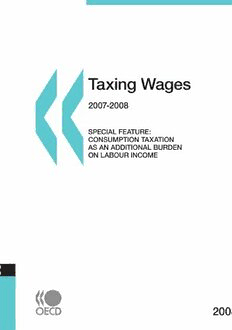
Taxing Wages 2008 PDF
490 Pages·2009·14.308 MB·English
Most books are stored in the elastic cloud where traffic is expensive. For this reason, we have a limit on daily download.
Preview Taxing Wages 2008
Description:
Taxing Wages provides unique information on income tax paid by workers and on social security contributions levied upon employees and their employers in OECD countries. In addition, this annual publication specifies family benefits paid as cash transfers. Amounts of taxes and benefits are detailed program by program, for eight household types which differ by income level and household composition. Results reported include the marginal and effective tax burden for one- and two-earner families, and total labour costs of employers. These data on tax burdens and cash benefits are widely used in academic research and in the preparation and evaluation of social and economic policy making. Taxing Wages 2008 includes a Special Feature entitled ""Consumption Taxation as an Additional Burden on Labour Income"". Table of Content : OVERVIEW 1. Introduction 2. Review of results for 2008 SPECIAL FEATURE Consumption Taxation as an Additional Burden on Labour Income -1. Introduction -2. Tax mixes in OECD countries -3. A methodology for consumption taxes in Taxing Wages -4. Availability and characteristics of Household Budget Survey data -5. Household identification -6. Expenditure identification and allocation of VAT/sales taxes rates and excise duties -7. Micro-simulation and results -8. Conclusions PART I: INTERNATIONAL COMPARISONS, TAX BURDENS 2008 ESTIMATES -Marginal rates -Graphical exposition of the 2008 estimated tax burden -Tax Burdens, 2007 definitive results PART II: TAX BURDEN TRENDS 2000-2008 -Historical trends -Important trends -Tax wedge -Personal average tax rate -Net personal average tax rate -Progressivity -Families PART III. COUNTRY DETAILS 2008 -Australia -Austria -Belgium -Canada -Czech Republic -Denmark -Finland -France -Germany -Greece -Hungary -Iceland -Ireland -Italy -Japan -Korea -Luxembourg -Mexico -Netherlands -New Zealand -Norway -Poland -Portugal -Slovak Republic -Spain -Sweden -Switzerland -Turkey -United Kingdom -United States PART IV. METHODOLOGY AND LIMITATIONS Methodology -1. Introduction -2. Calculation of gross wage earnings -3. Estimating gross wage earnings in 2008 -4. Coverage of taxes and benefits -5. Taxpayers characteristics -6. Calculation of personal income taxes -7. State and local income taxes -8. Social security contributions -9. Payroll taxes -10. Church tax -11. Family cash benefits from general government -12. Payable tax credits -13. The calculation of marginal tax rates Limitations -1. General limitations -2. Some specific limitations on the income tax calculation -3. Limitations to time-series comparisons A note on the tax equations Annex A Overall Tax Levels and Tax Structures in OECD Member countries, 1990-2005 Annex B Source of Earnings Data Annex C Exchange Rates and Purchasing Power Parties of National Currencies, 2007 Annex D Historical Series under the Old Definition of Average Worker
See more
The list of books you might like
Most books are stored in the elastic cloud where traffic is expensive. For this reason, we have a limit on daily download.
